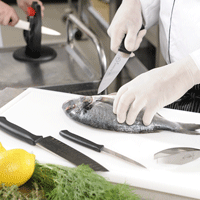Knife innovation keeps chefs on the cutting edge
As any chef knows, finding the right knife isn’t always cut and dry, it’s a personal choice that sends some culinary luminaries across country scouting the right blades to meet their cutting, slicing, dicing, boning, mincing or filleting needs.
“Chefs are collectors,” says Warren DeForest, director of Strategic Development for Food Supplies, Inc. in Concord, Ont. “Knives are like golf clubs. You buy them because of the way they look and their functionality.”
Yet every collector is unique. Some chefs stick to specific brands; others go out of their way to try anything new and different. For most, the final decision is a mixture of many variables. In fact, it’s not unusual to find collections that include everything from a $10-paring knife, purchased at a local store, to a specialty item worth thousands of dollars.
Technically Speaking
There are many elements that factor into a chef’s purchasing decisions — from fit and finish to aesthetics and performance. From the aesthetic standpoint, heritage lines are growing in popularity. DeForest points out Damascus steel knives, for example, are reminiscent of designs that date back half a century. Produced by bonding ultra-fine layers of steel, these knives can range in price between $250 and $1,000 or more if a buyer opts for exotic handles such as rosewood or plumwood.
“A lot [of chefs] want Damascus patterns and hammer finishes,” Eugene Ong, owner of the high-end Knife retail store in Toronto, says agreeing with DeForest. “We also sell a lot of western-style blades that are ground more evenly on the edging rather than beveled, and the handles usually tend to be the wood with rivets versus a single piece of wood. Many like the aesthetic of a wood handle — we sell a lot of magnolia, rosewood and pakkawood for both Japanese and western-style knives.”
Of course, wood has its drawbacks, too. And, in the interests of health and safety, some chefs are being drawn to more durable, easy-to-clean resin handles to avoid bacterial contamination. More specifically, DeForest notes that different coloured handles are becoming popular in kitchens in response to Hazard Analysis and Critical Control Points (HACCP) guidelines and concerns about the risk of cross-contamination.
Knives can also range from the general to the very specialized. For example, Ong stocks a Soba Kiri knife, specifically made for cutting soba noodles ($250) and an Unagi Saki knife ($400) for slicing eel. Japanese-style boning knives (Hankotsu) are especially versatile and sell for about $150. Top-selling Japanese brands include Misono, Suisin, Moritaka and Mcusta Zanmai. While Shun Knives and Kasumi both produce Japanese knives in the U.S., authenticity is what matters. “Otherwise it’s like getting a Ferrari made in Mexico,” Ong adds.
Leaders of the Pack
Everyone has their favourites, but DeForest reports that German-manufactured knives and tools continue to be the top-sellers, with brands such as Friedr. Dick, Wüsthof and Zwilling J.A. Henckels among the leaders. But, Japanese-style knives have also begun to gain attention for their curved, thin blades. The Santoku, for one, is quickly becoming a chef favourite.
Ong, who specializes in selling all variations of Japanese knives, can understand the popularity of the Asian-made culinary tools. “They are better for chefs working with them for hours a day because there’s less stress on the arm. Japanese blades are also harder, so they can be more resilient. And, they look awesome!”
The weight and handle size of knives have become increasingly important considerations as more women enter the foodservice profession, DeForest notes. “Every brand now offers a slightly smaller line for that purpose.”
Donna Dooher, 30-year industry vet, executive chef and proprietor of Mildred’s Temple Kitchen in Toronto, agrees that knives have to fit personal style. “[It] is like a glove — the grip needs to feel comfortable, the weight and the flexibility of the blade need to suit the individual, their size, their strength and the function of the blade. The technology for forging knives has changed over the years and we now have sleeker, lighter, more visually appealing knives to choose from.”
Survey Says
As a chef who butchers his own meat in-house, Fabio Bondi, from Local Kitchen & Wine Bar in Toronto admits having a versatile knife to do most of the work is important. “I use an all-steel Japanese blade by Global, since I need something that doesn’t require a lot of maintenance and stays sharp longer.” For greasier butchering jobs however, he prefers a wooden or plastic handle to avoid slippage. And, for the tough job of cutting through bones, he packs a meat saw.
David Gunawan, executive chef of West restaurant in Vancouver, counts Japanese blades among his favourites. “It’s an addiction. I get a new one every six or seven months,” he confesses. His collection now includes a Deba knife for filleting fish, a Yanagiba sashimi knife and a Kiritsuke knife for general cutting and chopping.
One he covets is an Aoko Blue Carbon steel knife that features a chromium and tungsten blade. “The steel makes all the difference. One of those could cost you $2,000 to $3,000,” he says. White steel shironiko knives, however, can be bought for between $500 and $600.
Toronto’s Dooher is a fan of carbon steel, too. “But like so many aspects of our lives these days, the time is not always available for the maintenance they require,” she confesses.
For the “muscle” work, Gunawan uses German-made knives. “Cleavers, for example, are great for times when you need less precision.” He also thinks Japanese/west-ern hybrids, such as those made by Misono and Suisin, deliver good value for the price.
Staying Sharp
Whatever the investment, proper treatment of blades can turn a high-end purchase into a lifelong investment. Hand sharpening, using varying degrees of whetstones, is the most precise and best way to ensure the longevity of blades, says Knife’s Ong.
“Steels don’t sharpen a blade, they just realign it,” he explains. “Grinders can be too abrasive and generate too much heat on the edge. Using whetstones is a much more gentle and precise process that doesn’t add heat.”
For someone investing in a solid whetstone collection for everyday sharpening purposes, Ong suggests using a 400, 1,000, 3,000 and 6,000 grit (or particles of sand per square inch). Prices range between $50 and $400.
Purchasing, handling and maintaining a good knife collection requires an appreciation for science and art. It comes down to personal choice and, considering the selection of knives on the market today, chefs have no shortage of good blades to keep them on the cutting edge for years to come.





















